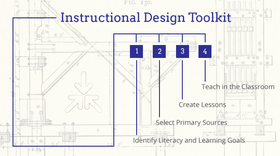Primary Source Exemplar: Nutrition and Human Rights
Performance Task Assessment Overview
The culminating performance task is designed to allow students to demonstrate literacy skills, understanding, perspectives and specific domain knowledge necessary to grapple with and/or answer the essential question. This can be an individual task, or a collaborative performance task along with individual tasks that contribute to the collaborative task, so that teacher can evaluate individual performance.
Students will write a proposal to a government agency that provides solutions to barriers to equitable diets. In writing these proposals, students make over-arching connections between childhood malnutrition, barriers to food equity and the impact of human nutrition on the global ecosystem. Students will present their proposals to the class and the class will evaluate and select top priorities that should be addressed by governmental sources and evaluate positive and negative effects of their proposed solutions.
Learning Objectives
Students will be able to create a local action plan for nutrition shifts by incorporating research on malnutrition and ecological efficiency.
Standards Addressed
CCSS R-1 Cite specific textual evidence to support analysis of science and technical texts.
CCSS R-7 Integrate quantitative or technical information expressed in words in a text with a version of that information expressed visually (e.g., in a flowchart, diagram, model, graph, or table).
CCSS W-1 Write arguments focused on discipline-specific content.
HS-LS2-7 Design, evaluate, and refine a solution for reducing the impacts of human activities on the environment and biodiversity.
Synthesizing Information and Writing – Evaluating Barriers and Writing Proposals
Students will individually select two barriers that prevent nutrition equity, and brainstorm and research possible solutions to each of those barriers. They will write a proposal to a government agency that:
Proposes a solution to the nutritional barrier,
Explores both the positive and possible outcomes on other aspects of the ecosystem as a result of those solutions.
Includes suggestions for how to mediate negative effects on the ecosystem (e.g. natural pesticides like ladybugs or planting more trees to decrease soil erosion).
Specifically points out how the solution benefits the human rights of a specific population.
Cites data on why malnutrition is a global concern.
Uses academic vocabulary introduced throughout the unit.
Students then present their proposals to the class and vote as a class for the most feasible proposals.
Assessment
Students will have:
Evaluated all the work they have done for the unit.
Reviewed and synthesized information from various primary sources
Written a proposal that addresses a specific barrier to equal access to an appropriate diet, or addresses the consequences of a nutritional shift.
Written a paper that uses scientific and academic language.
Teachers can evaluate students’ progress by:
Giving feedback on student analysis of how barriers to nutrition are a global human rights issue to ensure students are incorporating issues locally and globally.
Monitoring whether students can see how changing one component of the food ecosystem can influence others, such as by using polling or whiteboard responses.
Providing feedback to students as they choose their two barriers and brainstorm possible solutions. Students may need probing questions to be reminded to consider both biotic and abiotic (living and non-living) components that could be impacted.
Aid students in prioritizing their barriers in terms of urgency.
Providing feedback on students’ use of scientific and academic language while writing their proposals
Adaptations
Students could be assigned a specific problem, solution or risk mitigation.
Supports
Students could work in partners or small groups instead of individually.
